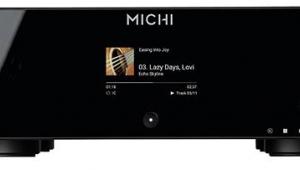Kalista DreamPlay ONE CD player Sidebar
For its first fully integrated CD player in a decade, Kalista is offering all six of the 8x upsampling modes built into AKM’s ‘Velvet Sound’ AK4497 DAC. Ordinarily, we would expect the two linear-phase ‘Sharp Roll-off’ filters to have a very flat response, good stopband rejection but greater time domain distortion, and the four ‘Slow Roll-off’ filters to have an ideal time domain response but poor stopband (alias) rejection and limited treble extension. In this case, however, differences in sound quality between all six filters may be less obvious because the player has an additional low-pass filter that presents a rolled-off treble in all modes!

Here’s the effect: the ‘Sharp Roll-off’ and ‘Short Delay/Sharp roll-off’ filters [black traces, see Graph] have pre/post ringing (worse in Short Delay) but a fine 99dB alias rejection and –1.7dB/10kHz to –4.5dB/20kHz response. By contrast the ‘Slow Roll-off’ and ‘Short Delay/Slow Roll-off’ [red] offer a mere 7.1dB alias rejection but superior impulse response and a frequency response that’s –1.8dB/10kHz to –9.4dB/20kHz. Finally, the ‘Low Dispersion’ and ‘Super Slow Roll-off’ filters [Green] offer almost no rejection of alias distortions (2.8dB) but boast a near-perfect time domain behaviour, minimum group delay and a ‘sweetened’ response that rolls away to –2.5dB/10kHz to –7.7dB/20kHz. My choice? With most tube amps, I’d use the ‘Sharp Roll-off’ filter but with very linear (wide bandwidth/low THD) amps I’d recommend trying the ‘Low Dispersion/Short Delay’ filter. PM



















































